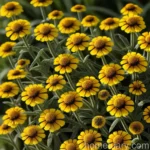Sneezeweed (Helenium ‘Ruby Charm’): A Comprehensive Guide
What is sneezeweed (Helenium ‘Ruby Charm’)?
Sneezeweed, scientifically known as Helenium ‘Ruby Charm’, is a stunning perennial plant that belongs to the Asteraceae family. It is widely admired for its vibrant and charming daisy-like flowers which bloom in hues of deep ruby red. This compelling plant is cherished by horticulturists and gardening enthusiasts for its remarkable ornamental value and its ability to attract pollinators to the garden.
Key Takeaways
Before delving into the detailed care and cultivation guidelines, let’s take a look at some key takeaways about sneezeweed (Helenium ‘Ruby Charm’).
- Botanical Name: Helenium ‘Ruby Charm’
- Common Name: Sneezeweed, Ruby Charm sneezeweed
- Plant Type: Perennial
- Flower Color: Ruby-red
- Hardiness Zone: 4-8
- Sunlight Requirement: Full sun
- Watering: Average water needs
- Soil Type: Well-draining, fertile soil
- Mature Size: 36-42 inches in height, 18-24 inches in width
- Attracts: Butterflies, bees, and other pollinators
- Special Feature: Deer-resistant, rabbit-resistant
Now, let’s explore the culture and uses of this enchanting plant, along with the essential care guidelines for its maintenance and propagation.
Culture
Water
Sneezeweed, Helenium ‘Ruby Charm’, thrives best in moderately moist soil. Adequate watering is crucial, especially during the plant’s active growth and blooming periods. However, it is vital to avoid overwatering, as the plant may be susceptible to root rot in waterlogged conditions.
Sunlight
Being a sun-loving perennial, sneezeweed thrives when planted in full sun or at least in an area with ample sunlight exposure. With a minimum of six hours of direct sunlight per day, Helenium ‘Ruby Charm’ will exhibit robust growth and an abundance of radiant blooms.
Soil
Sneezeweed favors well-draining, fertile soil. It is best to plant it in soil with a slightly acidic to neutral pH range. Additionally, incorporating organic matter into the soil can be beneficial for the plant’s growth and overall health.
Fertilizer
To promote vigorous flowering and healthy foliage, it is advisable to feed sneezeweed with a balanced, slow-release fertilizer in the early spring. This provides the necessary nutrients for the plant’s growth and sustenance throughout the growing season.
Uses
Garden and Landscape
Helenium ‘Ruby Charm’ is a striking addition to garden borders, cottage gardens, and mixed perennial beds. Its vibrant ruby-red flowers inject a bold pop of color into the landscape and serve as a captivating focal point when planted en masse or in clusters. Furthermore, its attractive blooms make it an exquisite cut flower for floral arrangements and bouquets.
Pollinator Garden
As an added benefit, sneezeweed is a potent pollinator attractant, drawing in an array of butterflies, bees, and other beneficial insects. Planting it in a pollinator garden contributes to the preservation and enhancement of local biodiversity, while also adding visual appeal to the space.
Pruning
Pruning sneezeweed, Helenium ‘Ruby Charm’, benefits the plant by promoting a bushier growth habit and encouraging the production of more blooms. Prune the plant in early spring, removing any dead or decaying foliage, and trimming it back to the desired size to maintain a neat and tidy appearance.
Propagation
Division
The most common method of propagating sneezeweed is through division. Divide the plant in early spring or fall, ensuring that each division has a good portion of roots attached. Replant the divisions in prepared soil, and water them thoroughly to help establish the new plants.
Seed Propagation
To grow sneezeweed from seeds, sow the seeds in well-prepared seed-starting mix in the early spring. Keep the soil consistently moist and provide warmth and bright indirect light. Once the seedlings are large and strong enough, they can be transplanted into the garden.
Container
Sneezeweed, Helenium ‘Ruby Charm’, can also be successfully grown in containers. Choose a sizable container with adequate drainage holes, and fill it with well-draining potting mix. Position the container in a location that receives ample sunlight, and water the plant regularly to ensure the soil remains evenly moist.
Popularity
The popularity of sneezeweed, particularly the Helenium ‘Ruby Charm’ variety, has been steadily increasing among gardeners and landscape enthusiasts. This surge in popularity can be attributed to its outstanding ornamental attributes, ease of cultivation, and its contribution to supporting local pollinator populations.
Common Diseases and Pests
Diseases
While sneezeweed is generally resistant to most diseases, it can occasionally fall prey to fungal issues such as powdery mildew. To prevent fungal diseases, ensure proper air circulation around the plants and avoid overhead watering. Additionally, promptly remove any affected foliage to prevent the spread of the disease.
Pests
Sneezeweed is relatively resistant to pests; however, it may occasionally encounter attacks from aphids, spider mites, or thrips. Regularly inspect the plant for any signs of pest infestations, and consider using natural pest control methods if necessary.
Disease Diagnosis
Understanding the symptoms and signs of common diseases and pests that affect sneezeweed (Helenium ‘Ruby Charm’) is crucial for effective disease diagnosis and prompt intervention. Here are some typical symptoms to watch out for:
Powdery Mildew
Symptoms: White, powdery patches on the upper surface of the foliage, often leading to distorted growth and reduced plant vigor.
Aphids
Symptoms: Curling and yellowing of leaves, sticky honeydew residue on the foliage, and the presence of small, soft-bodied insects on the plant.
Spider Mites
Symptoms: Fine webbing on the foliage, stippling or yellowing of leaves, and decreased overall plant health.
Botanist’s Tips
1. Companion Planting
Pairing sneezeweed with complementary companion plants such as asters, coneflowers, and ornamental grasses can create visually captivating combinations while enhancing the overall biodiversity of the garden.
2. Wildlife Attraction
By cultivating sneezeweed, gardeners can create a wildlife-friendly garden environment, attracting bees, butterflies, and other beneficial insects that contribute to ecosystem health and vitality.
Fun Facts
- The common name “sneezeweed” is derived from the historical use of its dried leaves and flowers in making snuff.
- Helenium ‘Ruby Charm’ is a highly attractive flowering plant that showcases stunning hues of ruby red, making it an alluring addition to any garden or landscape.
Now that we have covered the essential aspects of sneezeweed (Helenium ‘Ruby Charm’), including its culture, uses, propagation, common diseases, and botanist’s tips, let’s explore some external resources for further information and insights.
Links to External Resources
- The Royal Horticultural Society – Helenium ‘Ruby Charm’
- Missouri Botanical Garden – Helenium autumnale
- University of Maryland Extension – Sneezeweed, Helenium autumnale
In conclusion, sneezeweed (Helenium ‘Ruby Charm’) is a captivating perennial plant that enthralls with its vibrant blooms and ornamental allure. By incorporating this charming plant into gardens, landscapes, and wildlife-friendly habitats, gardeners can create visually stunning and environmentally enriching spaces that celebrate the natural beauty of this remarkable species.















